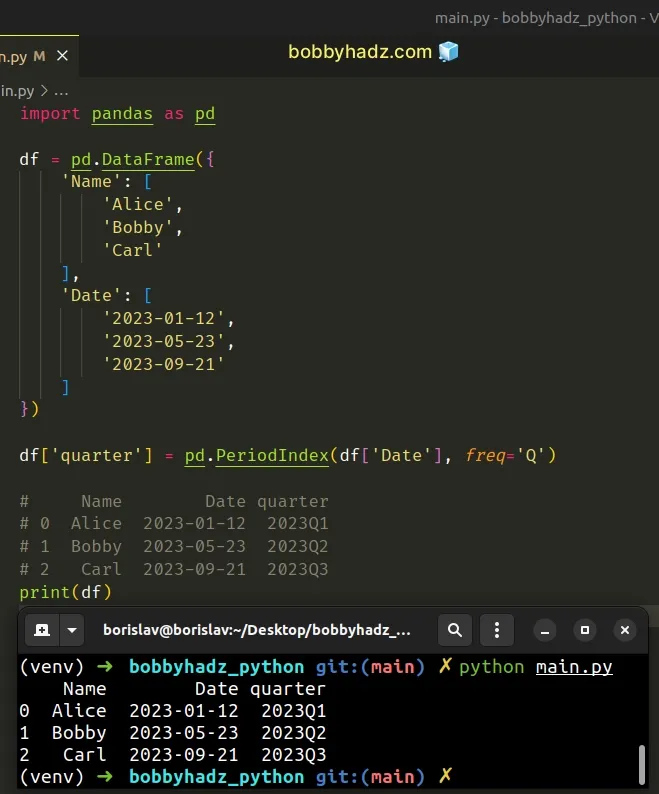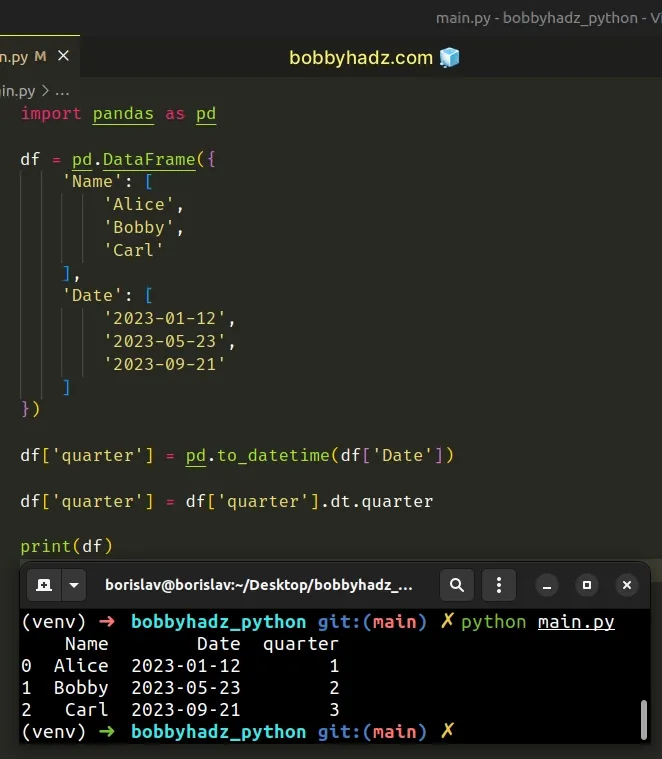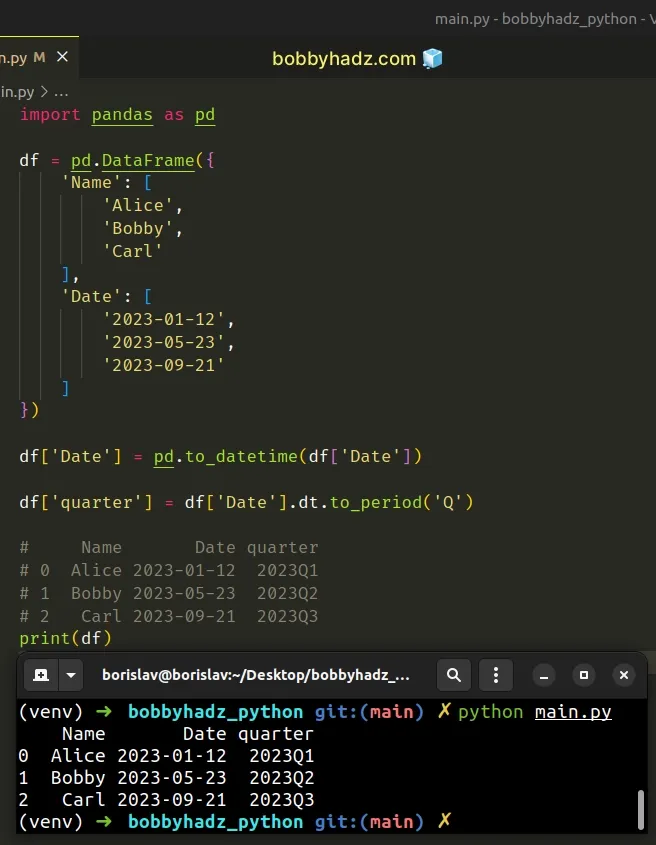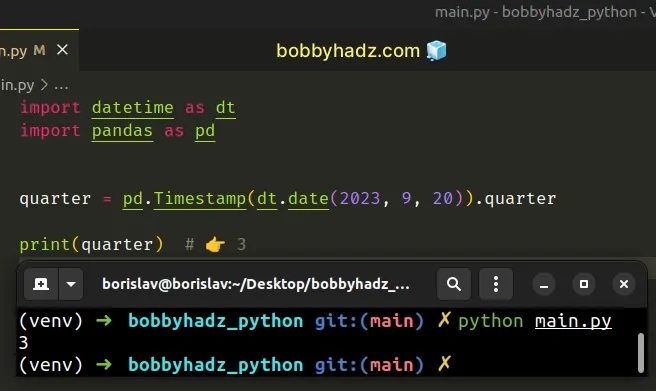How to get a Quarter from a Date in Pandas [4 Ways]
Last updated: Apr 12, 2024
Reading time·4 min

# Table of Contents
- How to get a Quarter from a Date in Pandas
- Get a Quarter from a Date in Pandas using dt.quarter
- Get a Quarter from a Date in Pandas using dt.to_period
- Get the quarter of a single Date using Pandas
# How to get a Quarter from a Date in Pandas
Use the pandas.PeriodIndex class to get a quarter from a date in Pandas.
The class takes a freq keyword argument that can be set to Q to get the
quarter that corresponds to each date in the DataFrame.
import pandas as pd df = pd.DataFrame({ 'Name': [ 'Alice', 'Bobby', 'Carl' ], 'Date': [ '2023-01-12', '2023-05-23', '2023-09-21' ] }) df['quarter'] = pd.PeriodIndex(df['Date'], freq='Q') # Name Date quarter # 0 Alice 2023-01-12 2023Q1 # 1 Bobby 2023-05-23 2023Q2 # 2 Carl 2023-09-21 2023Q3 print(df)

We used the
pandas.DataFrame
class to create a DataFrame from a dictionary.
The
pandas.PeriodIndex
class represents an immutable ndarray that holds ordinal values that indicate
regular periods in time.
The first argument we passed to the class is the period-like data to construct
the index with (the Date column).
df['quarter'] = pd.PeriodIndex(df['Date'], freq='Q') # Name Date quarter # 0 Alice 2023-01-12 2023Q1 # 1 Bobby 2023-05-23 2023Q2 # 2 Carl 2023-09-21 2023Q3 print(df)
The freq argument can be set to one of the available Pandas period strings.
You can view the available values for the freq argument in
this section
of the docs.
# Get a Quarter from a Date in Pandas using dt.quarter
You can also use the dt.quarter attribute to get a quarter from a Date in
Pandas.
- Use the pandas.to_datetime class to
convert the date column strings to
datetimeobjects. - Use the
dt.quarterattribute to get the quarter of each date.
import pandas as pd df = pd.DataFrame({ 'Name': [ 'Alice', 'Bobby', 'Carl' ], 'Date': [ '2023-01-12', '2023-05-23', '2023-09-21' ] }) df['quarter'] = pd.to_datetime(df['Date']) df['quarter'] = df['quarter'].dt.quarter # Name Date quarter # 0 Alice 2023-01-12 1 # 1 Bobby 2023-05-23 2 # 2 Carl 2023-09-21 3 print(df)

We first used the pandas.to_datetime() method to convert the Date column to
datetime.
Once we have a column containing datetime objects, we can access the
dt.quarter
attribute to get the quarter of each date.
Notice that the output only contains an integer that represents the quarter.
df['quarter'] = pd.to_datetime(df['Date']) df['quarter'] = df['quarter'].dt.quarter # Name Date quarter # 0 Alice 2023-01-12 1 # 1 Bobby 2023-05-23 2 # 2 Carl 2023-09-21 3 print(df)
We could've also converted the Date column to datetime in place and then
created the quarter column based on it.
import pandas as pd df = pd.DataFrame({ 'Name': [ 'Alice', 'Bobby', 'Carl' ], 'Date': [ '2023-01-12', '2023-05-23', '2023-09-21' ] }) df['Date'] = pd.to_datetime(df['Date']) df['quarter'] = df['Date'].dt.quarter # Name Date quarter # 0 Alice 2023-01-12 1 # 1 Bobby 2023-05-23 2 # 2 Carl 2023-09-21 3 print(df)
# Get a Quarter from a Date in Pandas using dt.to_period
You can also use the dt.to_period() method to get a quarter from a date in Pandas.
import pandas as pd df = pd.DataFrame({ 'Name': [ 'Alice', 'Bobby', 'Carl' ], 'Date': [ '2023-01-12', '2023-05-23', '2023-09-21' ] }) df['Date'] = pd.to_datetime(df['Date']) df['quarter'] = df['Date'].dt.to_period('Q') # Name Date quarter # 0 Alice 2023-01-12 2023Q1 # 1 Bobby 2023-05-23 2023Q2 # 2 Carl 2023-09-21 2023Q3 print(df)

We first converted the values in the Date column to datetime objects.
We are then able to use the
dt.to_period
method to convert the datetime values to PeriodArray.
df['Date'] = pd.to_datetime(df['Date']) df['quarter'] = df['Date'].dt.to_period('Q') # Name Date quarter # 0 Alice 2023-01-12 2023Q1 # 1 Bobby 2023-05-23 2023Q2 # 2 Carl 2023-09-21 2023Q3 print(df)
The only argument the method takes is the frequency.
You can view the available values for the freq argument in
this section
of the docs.
We set the freq argument to "Q" to get the quarter of each date.
# Get the quarter of a single Date using Pandas
You can also use the quarter attribute if you need to get the quarter of a
single Date when using Pandas.
import datetime as dt import pandas as pd quarter = pd.Timestamp(dt.date(2023, 9, 20)).quarter print(quarter) # 👉️ 3

We used the
pandas.Timestamp()
method to convert the Python date to a Pandas datetime object.
We can then access the Timestamp.quarter attribute to get the quarter of the year.
# Additional Resources
You can learn more about the related topics by checking out the following tutorials:
- Cannot set a DataFrame with multiple columns to single column
- Pandas ValueError: cannot insert X, already exists [Solved]
- How to swap two DataFrame columns in Pandas
- Pandas: How to get the Max and Min Dates in a DataFrame
- Pandas SpecificationError: nested renamer is not supported
- Pandas: Select the Rows where two Columns are Equal
- Pandas: Out of bounds nanosecond timestamp [Solved]
- Pandas TypeError: no numeric data to plot [Solved]
- ValueError: If using all scalar values, you must pass index
- How to add a Filter to Pivot Table in Pandas
- Pandas: Remove special characters from Column Values/Names
- Pandas: Count the unique combinations of two Columns
- Pandas: Get the Business Days between two Dates
- Pandas: Create Scatter plot from multiple DataFrame columns
- Cannot mask with non-boolean array containing NA / NaN values
- Disable the TOKENIZERS_PARALLELISM=(true | false) warning
- RuntimeError: Expected scalar type Float but found Double
- Pandas: Convert timezone-aware DateTimeIndex to naive timestamp
- ValueError: Failed to convert a NumPy array to a Tensor (Unsupported object type float)
- ValueError: NaTType does not support strftime [Solved]
- Cannot convert non-finite values (NA or inf) to integer
- Pandas: Set number of max Rows and Cols shown in DataFrame

